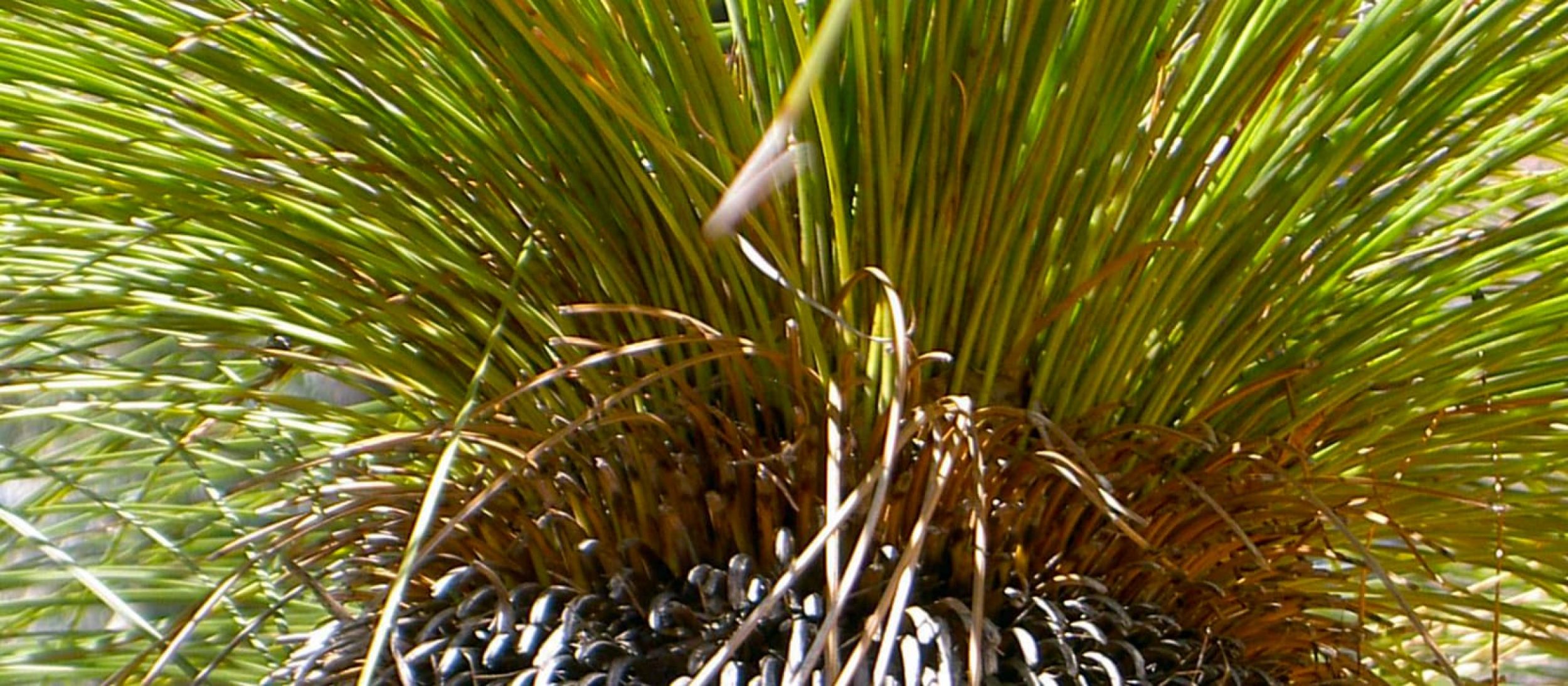
Grass Tree Wonderland

Earthwatch Australia
Today the weather favoured us and although the early morning brought light rain, the rest of the day was calm and mild and wonderful.
I had the opportunity today, to help botanists Natalie and James from the Royal Tasmanian Botanic Gardens, collect seed for the Tasmanian Seed Bank. A seed bank is where the seed from plants is stored in case the plant species in the wild is ever threatened or becomes extinct for any reason. There are some threatened plant species in the wild already and collecting seeds from these plants may be a way of regenerating them so that they are not lost for good.
In the morning we went to a forest of Xanthorrhoea on the Murrayfield property to check whether the seeds on these plants were ready for collection. The common name for Xanthorrhoea is Grass Tree. I had never seen this plant in such abundance anywhere else and it was a truly amazing sight. It reminded me of scenes from ‘Where the Wild Things Are’.

There were some ‘old man’ trees with hanging beards, some mutated flower spikes with two and three prongs, some trees that had split into two or three trunks, and there was one tree whose leaves had died and so a new set of leaves had started growing from lower down the trunk.
Some of the trees are estimated to be over 100 years old. These trees are a very slow growing species. Some sources suggest the young trees only grow a couple of centimetres per year. The trunks are actually the result of the leaves dying or being control burned, so they are layer upon layer of leaf stalks. Aboriginal people utilised every single part of this plant. Click here if you want to know more go.
In this forest we also saw some Kangaroo Apple, some Banksia and our own Victorian emblem plant the Common Heath (Epacris impressa).

Before we could enter our next location we needed to clean our boots so that we didn't take any disease from one area to another. This is a really important task that all scientists observe in order to keep all areas free from disease.
From here we headed south towards the Cape Bruny Lighthouse. On the road leading to the lighthouse we began our seed collecting task for the day. We were aiming to collect seeds from the Stringybark (Eucalyptus obliqua) and James had selected this area because the specimens there didn’t grow as tall as other specimens in the mountain region of the island. The Stringybark can grow up to 90 metres tall so it would be really hard to get seed from trees that tall without the help of an arborist (someone who climbs trees to prune them or cut them down). So the ones on the lighthouse road were a more reasonable height and James only had to use an extendable pole to cut the outer branches off so that Natalie and I could then remove and collect the seeds.
Eucalyptus obliqua is a formidable plant. It is the first ever described eucalyptus species described in 1777 by Dr Nelson who sailed with Captain Cook on his third voyage. The first trees seen by Nelson were on this island when Cook moored in Adventure Bay. Who knows, maybe some of the ones Nelson saw are still here!
James was mindful of harvesting seeds from towards the top of the tree rather than those from the lower branches because the higher ones usually contain cross-pollinated seeds, pollinated by honeyeaters, of all things. The lower branch seeds tend to be pollinated by flowers from the same tree and are thus tend to be less robust for propagation. Hence, finding shorter trees made for easier collection.

The collection process sees the botanists collecting seeds from 50 separate plants of the same species and within the same location for every single collection. Natalie explained that this would adequately ensure the greatest cross section of the genes of that population. We had only collected from 14 trees when James spotted another species of plant that seemed to grow in abundance in this particular place. That plant is the Hanging blueberry (Billardiera longiflora). After he and Natalie scouted the location they decided to take a break from the Stringybark collecting and go into the thick bramble woodland to collect the climbing Billardiera plant. This plant grows all over other trees and has a medium berry that can be white to red to purple in colour. To find 50 plants we had to fight through the bracken and brambles on the hillside. We lost each other for a little bit and James disturbed a wallaby sleeping at one stage but we all made it out alive with 44 samples. In no time at all we located another six samples on a beach path not too far from the original samples. With 50 samples collected we fulfilled another collecting job. We ended our day by completing half the Stringybark collection – 25 plants in all – to the rhythmic sounds of the Southern Ocean rolling into the South Bruny shore.
I didn’t see any other marsupials but we did see many more birds feasting on the low tide shellfish – teals and herons today.
Some answers to your questions...
I spoke to Dr Rob today about your questions and these are his answers:
How many species on this island and on Tasmania?
On Bruny there are about 160, and in Tasmania about 500. About 60 have been identified on Bruny so far.
What is the most common species found in Tasmania?
Probably the black house spider. it lives in and around houses and was the first spider that Dr Rob came into contact with.
What is the biggest spider found on Bruny Island?
The huntsman, or ’social’ spider which starred in 'Arachnophobia'.
Do White-tailed spiders have venom?
Almost all spiders have venom even the white tails, but most spider venom is very mild. In fact more recent evidence suggests that all spider venom including White-tailed spider venom contains an antibiotic.
Why are spiders specific colours?
The main reasons why spiders are coloured the way they are: for camouflage, for mating purposes, for warning signals and to mimic ants to keep them away from the spiders. If you want to know more about this you should google the question because there is so much more to find out. Especially look at the Peacock spider on YouTube - you will be amazed.
Is the funnel web the most venomous?
The Sydney Funnel Web is the most venomous and the Red Back is the most dangerous because the Red Back, whilst it injects less venom, causes just as severe a reaction and since they are smaller and widespread, many people will come into contact with Red Back spiders.
Are Red Back spiders deadly?
They can be, but they haven’t been so deadly since the antivenom was developed in 1964.
Why are they called Trapdoor spiders?
The term ‘Trapdoor’ refers to a big group of spiders. The ones Dr Rob found on the Mountain and at Coal Bay are called Misgolas. They dig a hole in the ground and live in it but they don't actually build a trap door. Other spiders who go by this name do build a trap door.
Are there Funnel Webs here?
They haven’t been found on Bruny Island yet.
Why do you like spiders so much Dr Rob?
I like spiders because they are eternally exciting. When you think you’ve seen it all, something amazing pops up. Spiders offer a microcosm of diversity.

